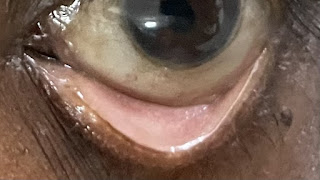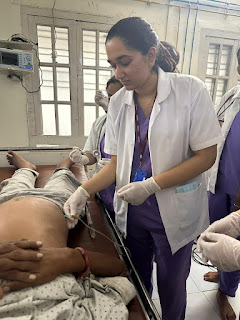45 year old male with Hyponatremia
Here we discuss our individual patient's problems through series of inputs from available global online community of experts with an aim to solve those patient's clinical problems with collective current best evidence based inputs.
This E log book also reflects my patient-centered online learning portfolio and your valuable inputs on the comment box.
Chief complaints:
Presented to the casualty with the complaints of sweating
and altered sensorium.
HOPI
The patient was apparently asymptomatic 10 years ago. He was
then diagnosed with Diabetes mellitus and is on OHAs for the past
10 years. He used to work in the Steel factory 6 years ago.
6 years ago, following unnoticed trauma he developed an ulceration on his left foot and little toe which became infected and had to be amputated. He was then also started on Insulin. 8 months ago, his 4th
toe of his left foot was amputated for similar reasons.
4 months ago, the patient had an ulcer on the foot following
injury of the foot which was not noticed by the patient and had to be treated
with debridement and split skin grafting.
1 month ago, the patient had an episode of seizure and was diagnosed to have hyponatremia. While being brought to the hospital he suffered a burn to the right foot due to the bike silencer.
3 days ago the patient skipped meals from the morning following which he then developed sweating, cooling of peripheries and altered sensorium in the afternoon. His GRBS was 55mg/dl on admission and was diagnosed with Hypoglycemia.
1 day ago the patient underwent fasciotomy and debridement for compartment syndrome following cellulitis of the left lower limb. The patient is scheduled for below the knee left leg amputation.
Daily routine :
The patient used to work in a Steel factory 6 years ago where he worked for 25 years. Following his foot problem he stopped working and was mostly confined to his home and surroundings. The patient’s appetite has also decreased in the past few years. His diet mainly consists of Roti and Ragi java. He is sometimes inconsistent with his meals and his current presentation of hypoglycaemia is due to skipping his meal after taking insulin.
Past History
No h/o HTN, TB, CAD, Asthma
H/o hypothyroidism diagnosed 6 months ago on regular check up and is currently on Thyronorm 25ug
H/o debridement of his diabetic foot ulcer with split skin grafting due to which the patient spent last 4 months mostly in the hospital.
Personal History
Diet: mixed
Appetite: normal
Sleep: adequate
Bowel and bladder: regular
Habits: none
Family history
Not significant
General Examination
The pt is drowsy on examination
Well oriented to time, place and person
Moderately built and moderately nourished
Pallor – Present
Icterus - absent
Cyanosis - absent
Clubbing – absent
Lymphadenopathy - absent
Edema – Mild pitting edema present on R lower limb
Temperature – Afebrile
HR – 70bpm
RR – 18 cpm
SpO2 – 97%
Systemic Examination
CNS:
Patient is drowsy but arousable
Memory: Intact.
Cranial Nerve Examination: All cranial nerves are functionally normal
Motor Examination: Right Left
UL LL UL LL
BULK Normal Normal Normal Cannot be examined
TONE Normal Normal Normal Cannot be examined
POWER 4/5 4/5 4/5 Cannot be examined
DEEP TENDON REFLEXES:
BICEPS 1 1
TRICEPS 1 1
KNEE 1 Not examined
ANKLE 1 Not
Sensory examination - Normal
Cerebellar examination - Finger nose coordination is normal
Signs of meningeal irritation are absent
Gait cannot be examined
CVS:
AUSCULTATION
Rate is normal
Rhythm is regular
S1, S2 heard, No murmurs
Respiratory:
Inspection:
Upper respiratory tract - oral cavity, nose & oropharynx
appears normal.
Chest appears Bilaterally symmetrical & elliptical in
shape
Respiratory movements appear equal on both sides and it's
Abdominothoracic type.
Trachea central in position & Nipples are in 4th
Intercoastal space
No signs of volume loss
No dilated veins, scars, sinuses, visible pulsations.
Palpation:
All inspiratory findings confirmed. Trachea central in position.
Apical impulse in left 5th ICS, 1cm medial to mid clavicular line
Right Left
Supraclavicular- (NVBS) (NVBS)
Infraclavicular- (NVBS) (NVBS)
Mammary- (NVBS) (NVBS)
Axillary- (NVBS) (NVBS)
Infra axillary- (NVBS) Crepitations
Suprascapular- (NVBS) (NVBS)
Interscapular- (NVBS) (NVBS)
Infrascapular- (NVBS) Crepitations
Abdomen:
Scaphoid in shape, soft, non-tender, bowel sounds
heard, no hepatosplenomegaly
INSPECTION
➤Shape - Scaphoid, with no
distention.
➤Umbilicus - Inverted
➤Equal symmetrical movements in
all the quadrants with respiration.
➤No visible pulsation, peristalsis, dilated veins and localized swellings
PALPATION
➤ No hepatomegaly
➤No splenomegaly
AUSCULTATION
➤ Bowel sounds present.
➤No bruit or venous hum.
Clinical

.jpeg)















.jpeg)



Comments
Post a Comment